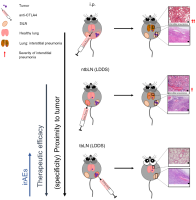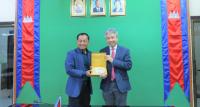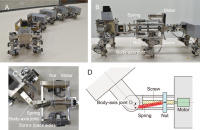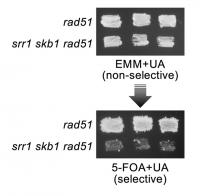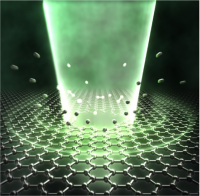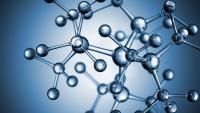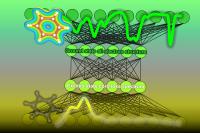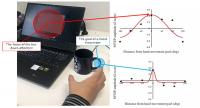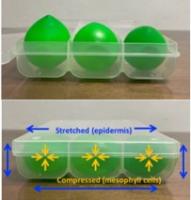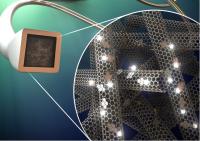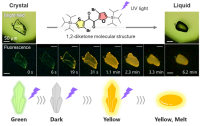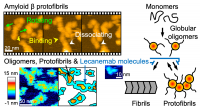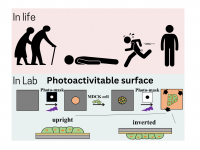Content is provided by our community of institutions, partners, researchers and journalists.
Tohoku University
01 Jun 2023
Scientists at Tohoku University have discovered a novel approach that improves the efficacy of immune checkpoint blockade - a novel form of cancer treatment utilizing immune checkpoint inhibitors - and minimizes the associated side effects. Using immune checkpoint blockades to target tumor-positive lymph nodes, they generated a robust anti-tumor response against both local and systemic metastases.
Hiroshima University
31 May 2023
Truck drivers unintentionally taking ‘microsleeps’ of a few seconds can cause terrible traffic accidents, but efforts and technologies aiming to prevent the problem have focused mainly on monitoring driver eye activity while missing a host of other key indicators of the problem.
The Education University of Hong Kong (EdUHK)
31 May 2023
A delegation led by President Professor Stephen Cheung Yan-leung of The Education University of Hong Kong (EdUHK) met with officials of Cambodia’s Directorate General of Higher Education (DGHE) of the Ministry of Education, Youth and Sport, in Phnom Penh, last month. The purpose of the visit was to follow up on discussions held during DGHE representatives’ visit to EdUHK in February 2023, and to strengthen educational collaboration between the University and the Cambodian Government.
Osaka Metropolitan University
30 May 2023
Osaka Metropolitan University scientists found that Japanese and Chinese, who are considered to have high-context cultures with a high degree of reliance on information shared by the speaker and listener, are code-switching from high-context cultures to low-context cultures when communicating with people from each other’s country. Furthermore, the scientists found that the Japanese do not engage in much code-switching with Chinese students in Japan.
Tohoku University
29 May 2023
Zinc is essential for our health. Our bodies must constantly regulate its zinc levels, otherwise fatal diseases such as cancers, growth failures, ad immunodeficiency can occur. Now, a research group has unearthed how zinc transporter complexes regulate zinc ion concentrations in different areas of the Golgi apparatus.
Osaka University
29 May 2023
Researchers from Osaka University show how their multilegged walking robot can be steered by inducing a dynamic instability. By making the couplings between segments more flexible, the robot changes from walking straight to moving in a curved path. This work can lead to more energy-efficient and reliable robotic navigation of terrain.
Asia Research News
26 May 2023
Asia Research News monitors the latest research news in Asia. Some highlights that caught our attention this week are a new sense added to VR, huge solar flares that may have helped spark life, and a volcanic eruption so big that it disrupted satellites.
Osaka University
26 May 2023
A research team, led by researchers from Osaka University, performed genetic screening of fission yeast lacking DNA repair gene Rad51 to identify genes that play a role in gross chromosomal rearrangement (GCR), a type of mutation that occurs at the centromere. Cells lacking Srr1 or Skb1 exhibited reduced GCR, indicating that these genes are important to the occurrence of GCR. These findings advance our understanding of the mechanisms underlying centromeric GCR.
Osaka Metropolitan University
26 May 2023
Eating fermented foods might be the secret to a healthy and long-lived society
Tohoku University
26 May 2023
Graphene has revolutionized materials science since its discovery in 2004, with its high electron mobility, mechanical strength, and thermal conductivity. But processing graphene at the micro/nanoscale is a challenging process that often involves large-scale equipment and complex operations. Now, Tohoku University researchers have applied their simple femtosecond laser technique to ultra-thin atomic layers of graphene, resulting in multi-point hole drilling without damaging the graphene film.
Newcastle University in Singapore
25 May 2023
A group of researchers from universities in Thailand and Malaysia have collaborated to develop a unique kind of film that is good for the environment and can decompose naturally. They made this film using leftover pineapple stems, which helps reduce the use of harmful plastic films. This new film has the potential to be used as packaging material, contributing to a more sustainable way of doing business and promoting a circular economy.
National Institute for Materials Science (NIMS)
23 May 2023
Two key challenges in chemistry innovation are solved simultaneously by exploring chemical opportunities with artificial intelligence.
Hokkaido University
23 May 2023
Acoustic signals can be effectively used for monitoring glacial runoff and provide a cheaper and more accessible alternative to existing methods.
Tohoku University
23 May 2023
With the use of electric vehicles and grid-scale energy storage systems on the rise, the need to explore alternatives to lithium-ion batteries has never been greater. Tohoku University researchers have recently developed a prototype calcium metal rechargeable battery capable of 500 cycles of repeated charge-discharge - the benchmark for practical use. The breakthrough was made thanks to the development of a copper sulfide nanoparticle/carbon composite cathode and a hydride-based electrolyte.
Institute of Industrial Science, The University of Tokyo (UTokyo-IIS)
23 May 2023
Researchers from the Institute of Industrial Science, The University of Tokyo, discover how certain colloids can form a solid-like gel and reveal how the mechanism differs from glasses.
MAP Academy
22 May 2023
From its origins as a wide sash worn as a part of ceremonial, military and everyday dress in the Indian subcontinent, to becoming a part of British military clothing that was thought to guard against cholera, the cummerbund has had a storied legacy. Read about how this humble accessory evolved over the years.
Asia Research News
19 May 2023
Asia Research News monitors the latest research news in Asia. Some highlights that caught our attention this week are a surprising antidote candidate for one of the deadliest mushrooms, why a certain species of spider walks like an ant, and the oldest primate embryos grown outside of the womb.
Institute of Industrial Science, The University of Tokyo (UTokyo-IIS)
19 May 2023
Researchers at the Institute of Industrial Science, The University of Tokyo, use artificial intelligence to help interpret data generated by material science spectroscopy experiments, which can aid in the development of new drugs and organic conductors.
Asia Research News
19 May 2023
Mushrooms 🍄get chattier after rainfall 🌧️, Two-organ chip answers fatty liver questions, History maps 🗺️vs future simulations, Restoring vision in blindness. Plus in our blog: Myanmar: Through eyes of leadership. Read all in the latest Editor's Choice.
Tohoku University
18 May 2023
It’s not unusual for many of us to reach for a cup of coffee or cup of tea whilst focusing our attention on a screen. Scientists have long pondered whether our hand movements influence our spotlight attention. And now a group of researchers from Tohoku University have discovered that our spotlight attention and the attention paid to our moving hands operates via independent mechanisms.
Asia Research News Partnerships
18 May 2023
Prioritising climate change, ITEX is encouraging inventors to push the boundaries of creativity and innovation to drive new climate technology
Duke-NUS Medical School
18 May 2023
Researchers have found the outcomes of depression and anxiety symptoms in Singapore’s youth to be troubling.
Osaka University
17 May 2023
A research group led by Osaka University has found that plant cells may be able to detect mechanical forces to determine their own position within the leaf—whether they are on the surface or in the inner tissues—and therefore differentiate into appropriate cell types after damage. These findings reveal how plants regenerate the correct type of tissues when damaged, and may improve our understanding of the mechanisms underlying the high regeneration potential of plants.
Tohoku University
17 May 2023
To improve the therapeutic techniques to treat those with brain disorders, researchers have developed microscopic, thermally-drawn microelectronic fiber-based neural probes as a means to manipulate both electrical and chemical signals in the brain. Now, a researcher from Tohoku University’s Frontier Research Institute for Interdisciplinary Sciences has led a group that increased the functionality of these fibers by equipping them with neurochemical sensing aptamers.
Hiroshima University
16 May 2023
Researchers have created a genetically edited allergen-free chicken egg that may be safe for those with egg white allergies.
Kanazawa University
16 May 2023
Researchers at Kanazawa University report in the Proceedings of the National Academy of Sciences of the United States of America (PNAS) high-speed atomic force microscopy experiments that show how ligands associated with stimulating and suppressing activation of the TRPV1 protein increase and decrease the molecule’s structural variations. The observations provide insights into how these heat- and chilli-sensing proteins function.
Osaka University
16 May 2023
Researchers at Osaka University discovered a new class of photo-responsive crystal compounds, heteroaromatic 1,2-diketones. Certain light irradiation causes the crystals in these materials to melt, dramatically changing the materials’ properties. One member of this class, SO, shows luminescent changes while melting, which enabled the research team to visualize the crystal-melting process at the molecular level. These findings provide fundamental insights into the mechanisms behind crystal melting and will enable future designs of light-responsive materials.
Kanazawa University
15 May 2023
Researchers at Kanazawa University report in Nano Letters how high-speed atomic force microscopy leads to insights into processes relevant to Alzheimer’s disease. Moreover, the technique is shown to be an excellent tool for studying the effect of drugs against the disease.
National Institute for Materials Science (NIMS)
12 May 2023
Specially coated surfaces help scientists investigate what happens when cell clusters are turned upside down.
Tohoku University
12 May 2023
An international research group has developed a new surface coating technology that is capable of significantly increasing electron emission in materials. Their breakthrough is expected to improve the production of high-efficiency electron sources, and lead to increased performances in electron microscopes, electron beam lithography systems, and synchrotron radiation facilities.


